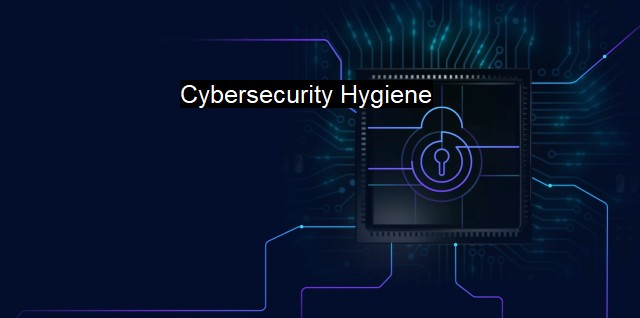What is Cybersecurity Hygiene?
The Importance of Maintaining Cybersecurity Hygiene in Today's Digital Age: Staying Ahead of Advanced, Dangerous, and Sophisticated Cyber Threats
Cybersecurity hygiene is an integral concept in today's digital world. As alarming rates of breaches and security incidents continue to rise, understanding cybersecurity hygiene and how it can safeguard your sensitive data has never taken on more importance. It refers to the daily practices and habits that help to maintain the overall health and security of your digital environment to keep you safe from potential threats.Usually, when one thinks of hygiene, it comes into the context of basic cleanliness and healthcare. Brushing your teeth, washing your hands, regular showers – all these routine habits fall under the umbrella of personal hygiene. You carry out these actions routinely, not necessarily because you are currently sick, but as a preventive measure against falling sick due to amongst other reasons, bacteria attack. Cybersecurity hygiene encompasses similar preventative measures, with the bacteria being replaced with cybersecurity threats.
Cybersecurity hygiene isn't restricted to just businesses or tech environments. For anyone using digital devices, maintaining strong cybersecurity hygiene forms a fundamental protective barrier. Given our increasing dependency on online systems for every little task, from remote working to online banking, the significance of cybersecurity hygiene cannot be overemphasize. Highly regulated industries, such as finance and healthcare, specifically, should pay extra attention to cybersecurity hygiene practices to ensure they are safe-guarding their customers' data appropriately.
One of the most rudimentary practices of good cybersecurity hygiene is creating strong, complex, and unique passwords. Using long, complex passwords boost chances against potential breaches. Far too often, people overlook this basic necessity – recycling the same passwords over multiple platforms. With credential stuffing attacks becoming evermore sophisticated, recycling passwords could easily allow cybercriminals to infiltrate multiple accounts after just one successful guess.
Another essential aspect of cybersecurity hygiene is implementing multi-factor authentication (MFA). This functions as an extra layer of protection in case passwords get compromised. Typical MFA procedures involve code generators, fingerprint scans, or other biometric data that bruteforcing software cannot emulate.
Running regular system and software updates also falls under solid cybersecurity hygiene. Often, these releases and upgrades contain patches for security vulnerabilities that cybercriminals can exploit. Keeping your systems up-to-date is akin to receiving a vaccine; the software is less likely to get "sick" and infect other parts of the computer.
Maintaining an updated antivirus solution is another critical component of cybersecurity hygiene. Antivirus software offers the first line of defense against most types of malware and are adept at detecting potential threats before they can cause any severe damage. It protects your digital space from ransomware attacks, phishing attempts, spreading viruses, and more, thereby facilitating a healthy digital environment.
The practice of RAT (regular audit and training) is part of cybersecurity hygiene as well. Regular audit of system and user activities helps to identify any vulnerability and handle it proactively. Training the staff of the organization enables them to comprehend the cybersecurity threat landscape and make informed decisions online.
Practicing secure browsing habits such as refraining from clicking suspicious links, not opening unknown email attachments, or visiting insecure websites are fundamental to good cybersecurity hygiene. These habits are the digital equivalent to washing one's hands – potentially easy ways to avoid harmful infections.
Cybersecurity hygiene plays a vital part in building strong, reliable resistance against malicious attempts to compromise systems or data in a business or a personal setting. In an age saturated by technology, quality cybersecurity hygiene will readily arm any individual or organization against an ever-evolving threat landscape.

Cybersecurity Hygiene FAQs
What is cybersecurity hygiene?
Cybersecurity hygiene refers to the best practices and techniques used to protect computer systems, networks, and sensitive information from cyber threats. It involves a series of practical steps, including antivirus software, firewalls, updates, and patches, to minimize the risk of cyber attacks.Why is cybersecurity hygiene important?
Cybersecurity hygiene is essential because it helps to prevent security breaches, data theft, and other cyber threats. By maintaining good cyber hygiene, you can protect your computer systems, networks, and data from malicious attacks and reduce the risk of cybercrime.What are some best practices associated with cybersecurity hygiene?
Some best practices associated with cybersecurity hygiene include using strong passwords, keeping software and operating systems up-to-date, using antivirus and anti-malware software, implementing firewalls, regularly backing up data, and educating employees about cyber threats and best practices.How can I improve my cybersecurity hygiene?
You can improve your cybersecurity hygiene by following a few simple steps, including installing antivirus and anti-malware software, implementing strong passwords, keeping software and operating systems updated, regularly backing up data, and training employees to identify and prevent cyber threats. Additionally, you should use caution when accessing email attachments or downloading software from untrusted sources, enable two-factor authentication where possible, and limit access to sensitive information.| | A | | | B | | | C | | | D | | | E | | | F | | | G | | | H | | | I | | | J | | | K | | | L | | | M | |
| | N | | | O | | | P | | | Q | | | R | | | S | | | T | | | U | | | V | | | W | | | X | | | Y | | | Z | |
| | 1 | | | 2 | | | 3 | | | 4 | | | 7 | | | 8 | | |||||||